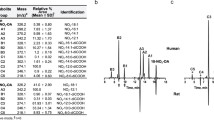Abstract
This study reports bioavailability and metabolism of fucoxanthin (FUCO) from brown algae Padina tetrastromatica in rats. Rats were divided into two groups (n = 25/group). Group one was fed basal diet (control) while the group two received retinol deficient diet (RD group) for 8 weeks. After confirmed RD in blood (0.53 μmol/l), rats were further sub-grouped (n = 5/sub group), intubated a dose of FUCO (0.83 μmol) and killed after 0, 2, 4, 6 and 8 h. The plasma levels (area under curve/8 h) of FUCO (fucoxanthinol (FUOH) + amarouciaxanthin (AAx)) was 2.93 (RD group) and 2.74 pmol/dl (control), respectively. No newly formed retinol was detected in RD rats intubated with FUCO. Besides FUOH (m/z 617 (M+H)+) and AAx (m/z 617 (M+H−)+), other deacetylated, hydrolyzed and demethylated metabolites of bearing molecular mass at m/z 600.6 (FUOH–H2O), m/z 597 (AAx–H2O), m/z 579 (AAx–2H2O+1), m/z 551 (AAx–2H2O–2CH3+2) and m/z 523 (AAx–2H2O–4CH3+4) were also detected in plasma and liver by LC-MS (APCI). Although biological functions of FUCO metabolites need thorough investigation, this is the first detailed report on FUCO metabolites in rats.







Similar content being viewed by others
References
Wang WJ, Wang GC, Zhang M, Tseng CK (2005) Isolation of Fucoxanthin from the Rhizoid of Laminaria japonica Aresch. J Integr Plant Biol 47:1009–1015
Sachindra NM, Sato E, Maeda H, Hosokawa M, Niwano Y, Kohno M, Miyashita K (2007) Radical scavenging and singlet oxygen quenching activity of marine carotenoid fucoxanthin and its metabolites. J Agric Food Chem 55:8516–8522
Maeda H, Hosokawa M, Sashima T, Funayama K, Miyashita K (2005) Fucoxanthin from edible seaweed, Undaria pinnatifida, shows antiobesity effect through UCP1 expression in white adipose tissues. Biochem Biophys Res Commun 332:392–397
Kotake-Nara E, Kushiro M, Zhang H, Sugawara T, Miyashita K, Nagao A (2001) Carotenoids affect proliferation of human prostate cancer cells. J Nutr 131:3303–3306
Asai A, Sugawara T, Ono H, Nagao A (2004) Biotransformation of fucoxanthinol into amarouciaxanthin a in mice and Hepg2 cells: formation and cytotoxicity of fucoxanthin metabolites. Drug Metab Dispos 32:205–211
Sugawara T, Baskaran V, Tsuzuki W, Nagao A (2002) Brown algae fucoxanthin is hydrolyzed to fucoxanthinol during absorption by caco-2 human intestinal cells and mice. J Nutr 132:946–951
Shiratori K, Ohgami K, Llieva I, Jin XH, Koyama Y, Miyashita K, Kase S, Ohno S (2005) Effects of fucoxanthin on lipopolysaccharide-induced inflammation in vitro and in vivo. Exp Eye Res 81:422–428
Sangeetha RK, Bhaskar N, Baskaran V (2008) Fucoxanthin restrains oxidative stress induced by retinol deficiency in rats through modulation of Na+Ka+-ATPase and antioxidant enzyme activities in rats. Eur J Nutr 47:432–441
Sangeetha RK, Bhaskar N, Baskaran V (2009) Comparative effects of ß-carotene and fucoxanthin on retinol deficiency induced oxidative stress. Mol Cell Biochem. doi:10.1007/s11010-009-0145-y (in press)
Oliveros L, Vega V, Anzulovich AC, Ramirez D, Giminez MS (2000) Vitamin A deficiency modifies antioxidant defences and essential element contents in rat heart. Nutr Res 20:1139–1150
Raju M, Lakshminarayana R, Krishnakantha TP, Baskaran V (2006) Micellar oleic and eicosapentaenoic acid but not linoleic acid influences the β-carotene uptake and its cleavage into retinol in rats. Mol Cell Biochem 288:7–15
Nagao A (2004) Oxidative conversion of carotenoids to retinoids and other products. J Nutr 134:237S–240S
Burri BJ, Clifford AJ (2004) Carotenoid and retinoid metabolism: insights from isotope studies. Arch Biochem Biophys 430:110–119
Ganguly J, Sastry PSM (1985) Mechanism of conversion of β-carotene into vitamin-A central cleavage versus random cleavage. World Rev Nutr Diet 45:198–220
Lakshminarayana R, Aruna G, Sangeetha RK, Bhaskar N, Divakar S, Baskaran V (2008) Possible degradation/biotransformation of lutein in vitro and in vivo: isolation and structural elucidation of lutein metabolites by HPLC and LC-MS (APCI). Free Radic Biol Med 45:982–993
Khachik F, deMoura FF, Zbao DU, Aebiscber CP, Bernstein PS (2002) Transformation of selected carotenoids in plasma, liver, and ocular tissues of humans and in nonprimate animal models. Invest Ophthalmol Vis Sci 43:3383–3392
Gajic M, Zaripheh S, Sun F, Erdman JW Jr (2006) Apo-8′-lycopenal and apo-8′-lycopenal are metabolic products of lycopene in rat liver. J Nutr 136:1552–1557
Moren M, Naess T, Hamre K (2002) Conversion of β-carotene, canxanthin and astaxanthin to vitamin A in Atlantic halibut (Hippoglossus hippoglossus) juveniles. Fish Physiol Biochem 27:71–80
Matsuno T (1991) Xanthophylls as precursors of retinoids. Pure Appl Chem 63:81–88
Goswami UC, Barua AB (1981) Intestinal conversion of lutein into 3-dehydroretinol in freshwater fish, Heteropneustes fossilis & Channa straitus. Ind J Biochem Biophys 18:88
American Institute of Nutrition (1977) Report of the American Institute of Nutrition Ad Hoc committee on standards for nutritional studies. J Nutr 170:1340–1348
Haugan JA, Akermann T, Jensen LS (1992) Isolation of fucoxanthin and peridinin. In: Packer L (ed) Carotenoids part A: chemistry, separation, quantitation and antioxidants. Methods in enzymology, vol 213. Academic Press Inc., Orlando, pp 231–245
Statsoft (1999) Statistics for Windows, Ver. 5.0. TULSA, Statsoft Inc, USA
Kaul S, Krishnakantha TP (1997) Influence of retinol deficiency and curcumin/turmeric feeding on tissue microsomal membrane lipid peroxidation and fatty acids in rats. Mol Cell Biochem 175:43–48
Bhosale P, Zhao da D, Serban B, Bernstein PS (2007) Identification of 3-methoxyzeaxanthin as a novel age-related carotenoid metabolite in the human macula. Invest Ophthalmol Vis Sci 48:1435–1440
Strand A, Herstad O, Jensen SL (1998) Fucoxanthin metabolites in egg yolks of laying hens. Comp Biochem Physiol 119:963–974
Olson JA (1994) Absorption, transport and metabolism of carotenoids in humans. Pure Appl Chem 6:1011–1016
Acknowledgements
This work was partially supported by the Department of Biotechnology, Govt. of India, New Delhi. The first author acknowledges the University Grant Commission, Govt. of India, New Delhi, for awarding Senior Research Fellowship. Authors acknowledge the help of Ms. Asha M and Mr. Mukund PL in chromatographic and mass spectrometric analyses.
Author information
Authors and Affiliations
Corresponding author
Rights and permissions
About this article
Cite this article
Sangeetha, R.K., Bhaskar, N., Divakar, S. et al. Bioavailability and metabolism of fucoxanthin in rats: structural characterization of metabolites by LC-MS (APCI). Mol Cell Biochem 333, 299–310 (2010). https://doi.org/10.1007/s11010-009-0231-1
Received:
Accepted:
Published:
Issue Date:
DOI: https://doi.org/10.1007/s11010-009-0231-1




